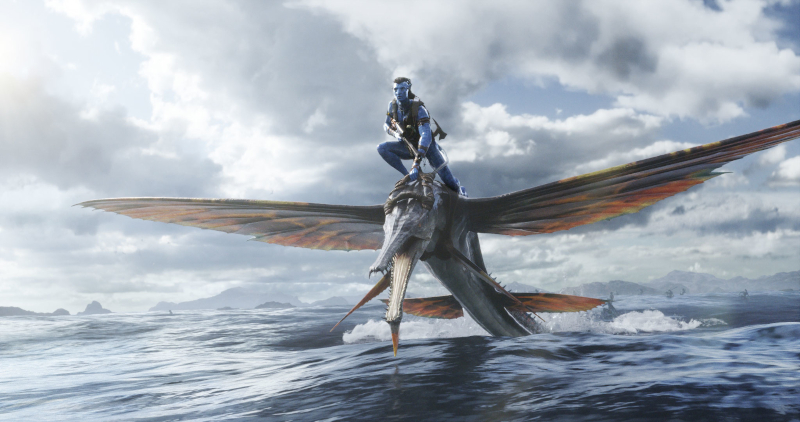Director – James Cameron – 2022 – US – Cert. 12a – 192m
Immersive Cinema *****
Screenplay *
Now raising their own family on the planet Pandora, a couple flee the attacking Sky People to live among a tribe of sea people – first Avatar sequel is back out in cinemas on Friday, October 3rd
Having gone native on the planet Pandora following the events in Avatar (James Cameron, 2009), in which paraplegic human soldier Jake Sully (performance capture including voice or Pcap: Sam Worthington) was transformed into an avatar of a non-disabled, native Pandoran, in the first third of the film, Jake is raising a family with Na’vi partner Neytiri (Pcap: Zoe Saldaña): two boys, two girls. They play in the jungle forest with their friend Spider (Jack Champion), a human child who was too young to be evacuated when the other Sky People left. Spider has been raised by human scientists who remained behind, and he must constantly wear a breathing mask to survive in Pandora’s atmosphere; he is to all intents and purposes feral.

When the Sky People return to Pandora with a new remit – to prep the planet for human habitation since the Earth is becoming uninhabitable – Jake’s old commander Quaritch (Pcap: Stephen Lang), who died in the first film but is now reconstituted as an an avatar embedded with the character’s DNA and memories, is determined to hunt down and kill the Sully who, as he sees it, betrayed him. After Quaritch attacks the Na’vi and captures Spider, Jake and family go on the run, soon settling among a distant, sea-based tribe of Na’vi led by Tonowari (Pcap: Cliff Curtis) and Ronal (Pcap: Kate Winslet) which Jake hopes will be beyond the reach of Quaritch. But Jake is wrong…
In the second third, the family attempt to integrate into the island-based, sea-hunter tribe with the emphasis on the children, particularly the younger boy and the elder daughter. The elder boy Neteyam (Pcap: Jamie Flatters) is the model son who always seems to do what his father wants and with whom his father is consequently well pleased; his younger brother Lo’ak (Pcap: Britain Dalton) can’t seem to get anything right in his dad’s eyes, and as a result suffers from low self-esteem and a constant need to prove himself.
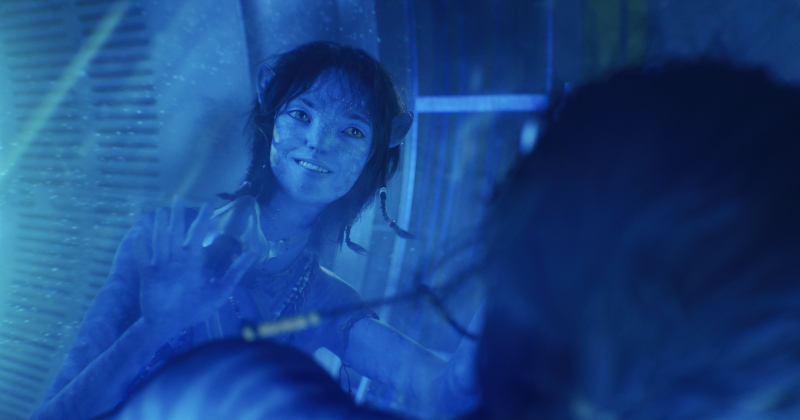
Meanwhile, the elder girl Kiri (Pcap: Sigourney Weaver) is the one member of the family who is adopted, the biological daughter of the scientist character played by the same actress in the original film. While the others learn to bond with giant flying sea reptiles much as they did with giant flying land reptiles in the first film, Kiri’s interfacing with the mother planet occurs on a deeper and more complex level. The younger girl Tuk (Pcap: Trinity Jo-Li Bliss) isn’t given a great deal to do by the script.
The final third sees Quaritch hunt down Jake and family who must then battle him to survive. Quaritch now has the conflicted Spider as part of his team, and travels in a commandeered whaling vessel which was originally charged with killing the beasts to extract a precious liquid which stops people from ageing, Actually, the film cleverly cuts back to this plot strand throughout its running length, which may be how it was written or may be something that was arrived at during the editing process, but the film marks out a section with the children interacting and grappling with the wonders and challenges of the natural sea world before this hunt / pursuit / fight section kicks in proper, so it makes sense to regard the hunt as the film’s final third.
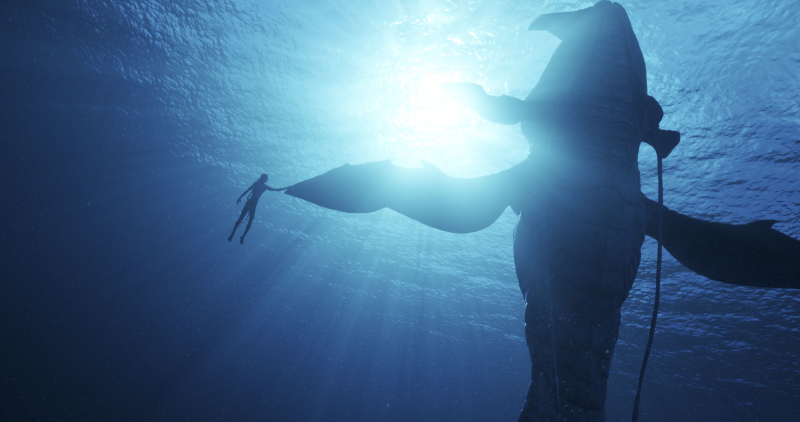
Frankly, though, the plot isn’t what anyone comes to this film for. (Just as well, because there are so many problems with it.) Cameron is a storyteller who paints with broad brush strokes, more so as his films have got bigger. Where another filmmaker might show a family attacked by outsiders in a brief scene or even a skilful, expository line of dialogue, he will deliver a lengthy battle scene with incredibly orchestrated action sequences, amazing creatures and sophisticated technological weaponry. Moreover, he’ll do it in 3D and a High Frame Rate (HFR) of 48 frames per second (fps) in such a way that you feel completely inside the picture. This presents incredible technical challenges, which he is very good at overcoming. It’s spectacular, mind-blowing and something audiences will flock to see. Me too – I love this sort of stuff. But. And it’s a big but. You need to have something to say.
Cameron’s view of the world, at least as far as it’s represented in this film, is deeply simplistic. He seems to divide his characters into, on the one hand, people who are in tune with ecology – here, scientists and Pandoran natives – and on the other hand military people for whom military objectives are the be all and end all, who trample the natural world in pursuit of those goals. But there are far more types of people than that, and if you reduce the world to those two types, it feels phoney and will undermine whatever it is you’re trying to say. Cameron’s movies have been going this way for a while, but at least The Abyss (1989), if you peel away all the surface detail about submarines and deep sea life forms, is about something complex – a couple’s irretrievable, marital breakdown.
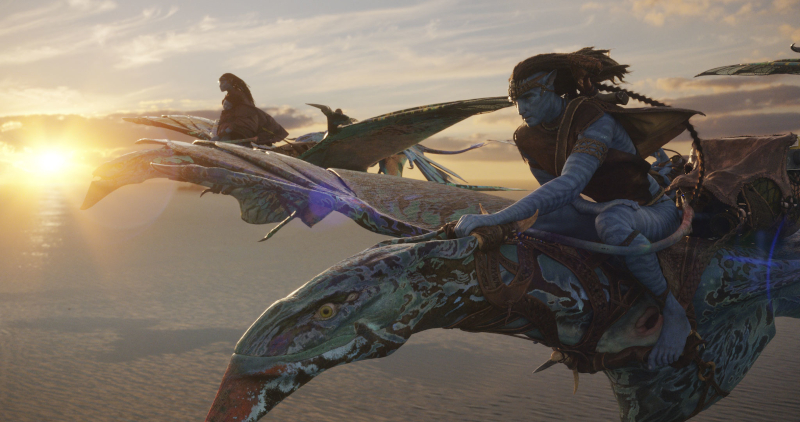
This first Avatar sequel (there are three more at least partly shot) purports to be about family dynamics, but on that level there doesn’t seem to be that much more to it than I’ve described above. There’s also a lot about planetary ecology, but that pretty swiftly boils down to a basic and overly simple Save The Whales message. Cameron prefers to put his creative energies elsewhere, but I wish he’d address this area more effectively. When I castigate the screenplay as I do in my ratings, what I mean is, the story is so obvious that I don’t care.
His view of gender doesn’t help that much, either. The males all seem to be about conquering the natural world, getting themselves or others into trouble, whereas the females are at one with the natural world and peacemakers. Again, in the real world, males and females operate with a whole range of nuances that make them far more complex than that. I put all this down to Cameron because highly capable screenwriters Rick Jaffa and Amanda Silva – who among other things revitalised the Planet Of The Apes franchise in its recent outings (2011, 2014, 2017) – are essentially augmenting co-screenwriter Cameron’s vision here.
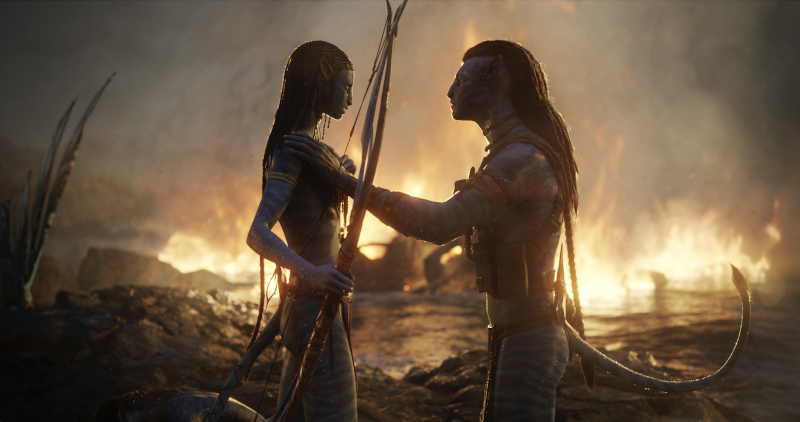
Cameron seems to work much like Ray Harryhausen, who would construct his films around incredible effects sequences (in Harryhausen’s case, with live action characters interacting with stop-frame animated creatures) which were amazing in their own right but featured in films where other elements often left much to be desired. They are generally films comprising incredible sequences rather than being in themselves incredible films. And that’s certainly true of Cameron’s new Avatar film.
For a comparison with another film director working in 3D and HFR, look no further than Ang Lee whose Gemini Man (2019) didn’t suffer from any of these issues. But then Lee was not trying to build an immersive world in the way Cameron is here, so perhaps that isn’t an entirely fair comparison.
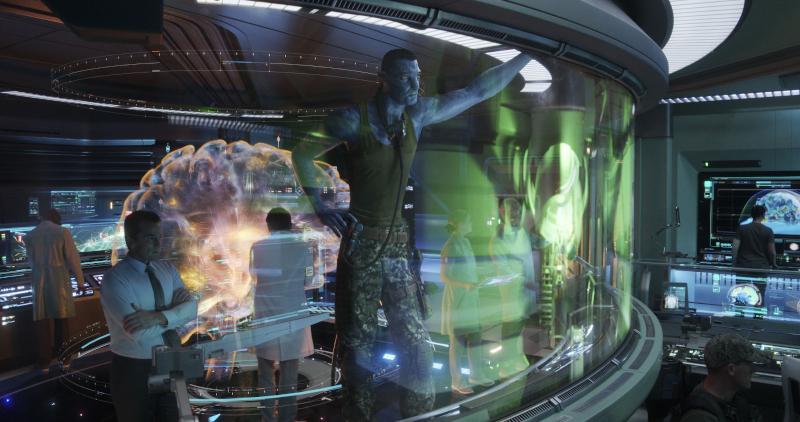
Script and story aside, Cameron pushes the envelope on a number of fronts as one bravura sequence follows another, and it takes your breath away. It doesn’t work all the time – sometimes the 3D and HFR just feels a little bit too hyperreal, but the overall level of detail is astonishing, whether you’re looking at flying lizards seen in the last film or underwater creatures new to this one, or a whale leaping onto the deck of a boat to crush humans who are tormenting it, or incredible manned craft that resemble crabs scuttling about.
There are whales completely convincing as characters, and elsewhere some of the actors’ performances are extraordinary… with much of the Pcap work shot with actors in water or underwater, whose movements are then dropped into virtual bodies in the virtual environment we see on the screen. This could just be a rig for elaborate special effects, but no, Cameron is interested in getting performances out of his cast. He hits paydirt with Sigourney Weaver, now a septuagenarian, playing a teenager; in this role, working with all this technology – no easy task for an actor – she is extraordinary.
This may have its weaknesses, but as a piece of immersive cinema – which is the reason people will want to see it, on a huge screen, in 3D and HFR 48 fps – it is absolutely peerless. That said, I never, ever expected to write the following about any movie… However… this is at once one of the year’s best (thanks to its technical innovation) and a turkey (thanks to its simplistic screenplay).
And now you can see it on a smaller screen in digital.
Avatar: The Way Of Water is back out in cinemas in the UK on Friday, October 3rd 2025. Original release in cinemas on Friday, December 16th 2022.
Trailer:
